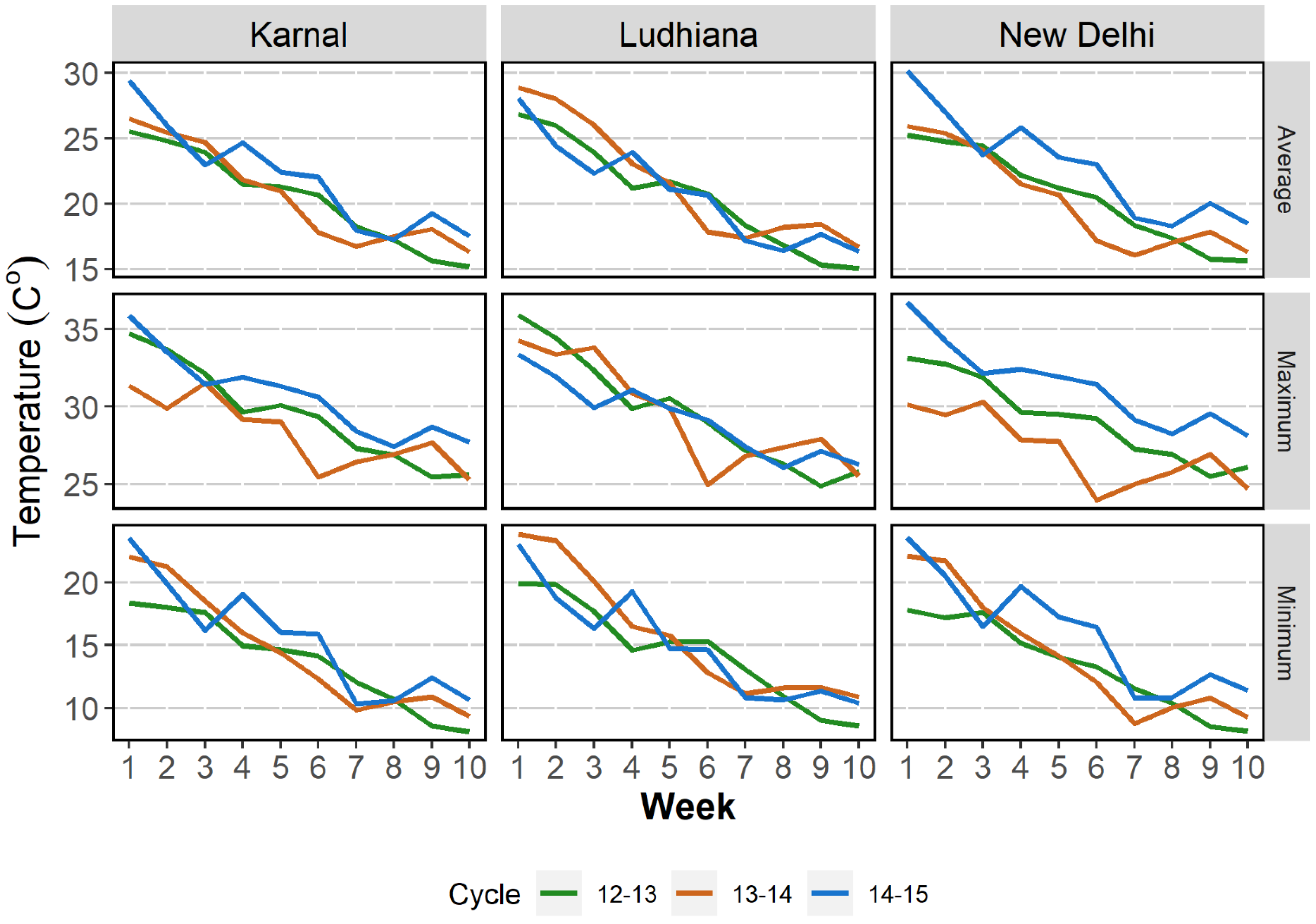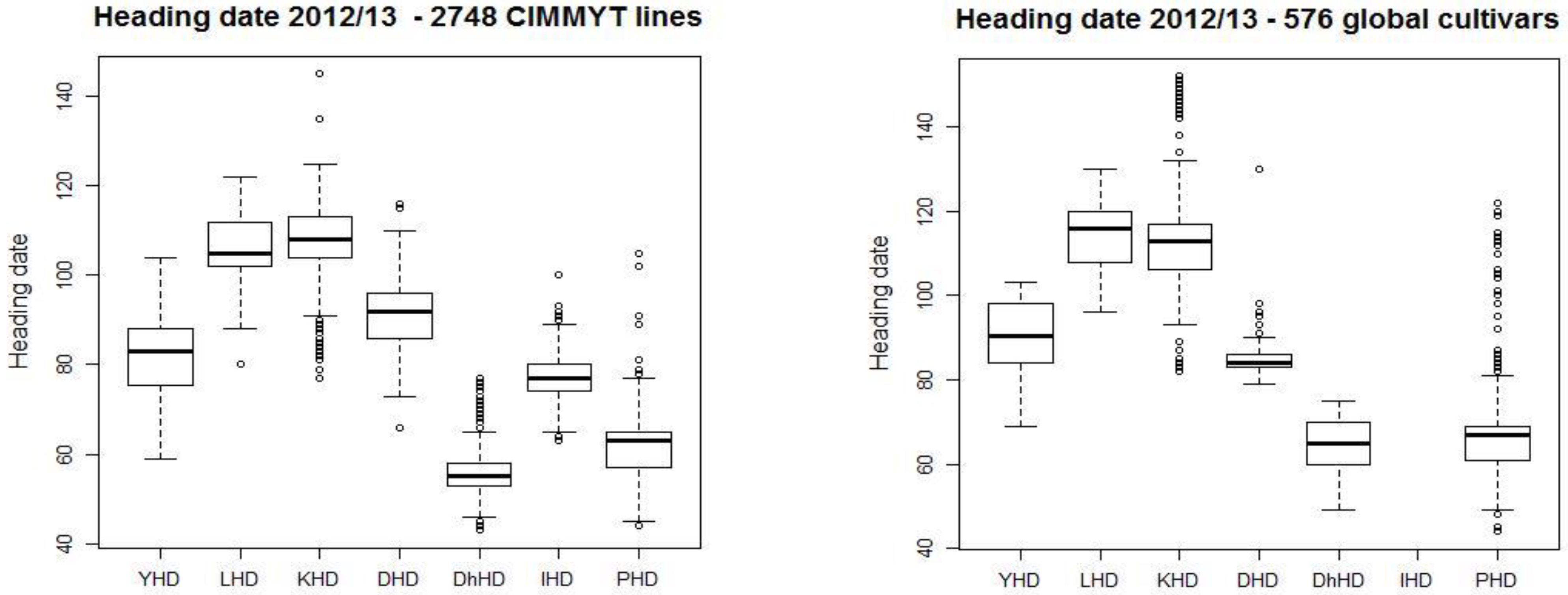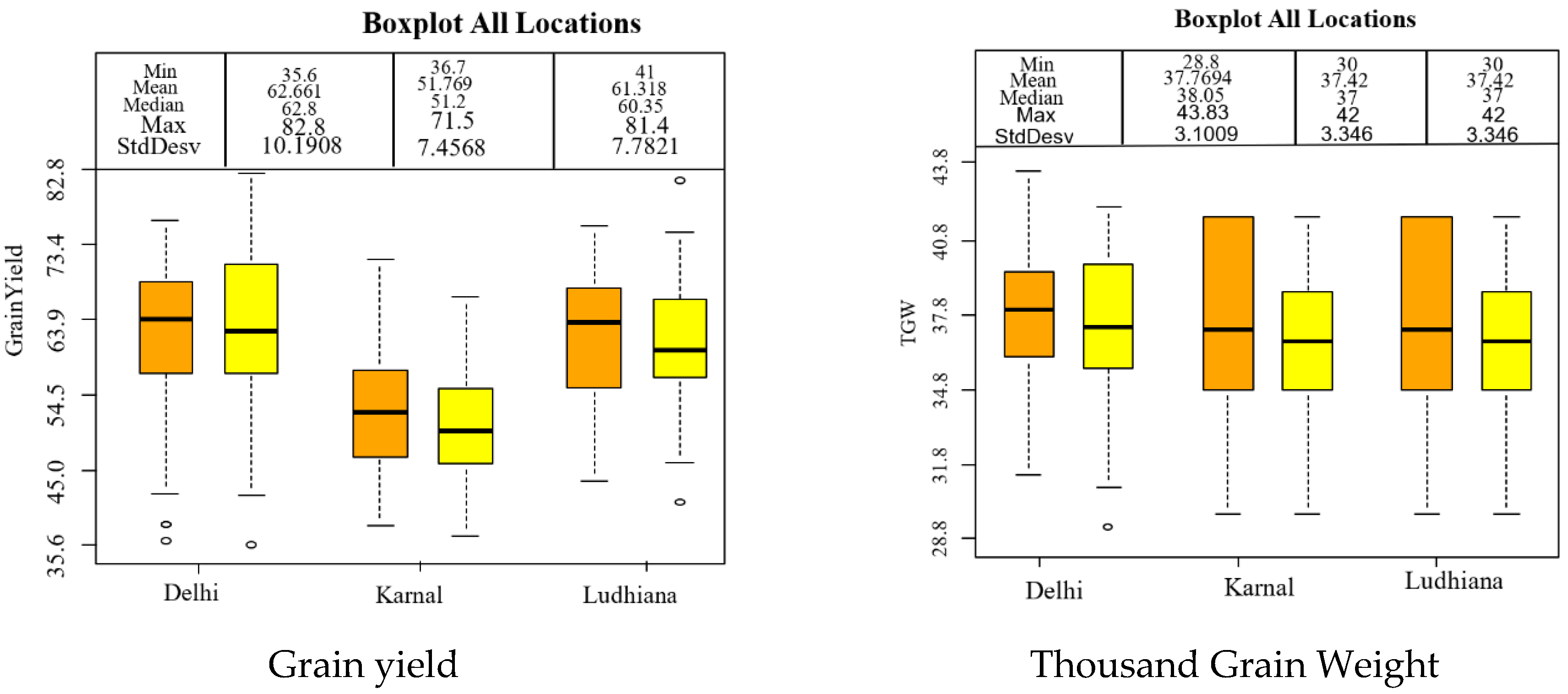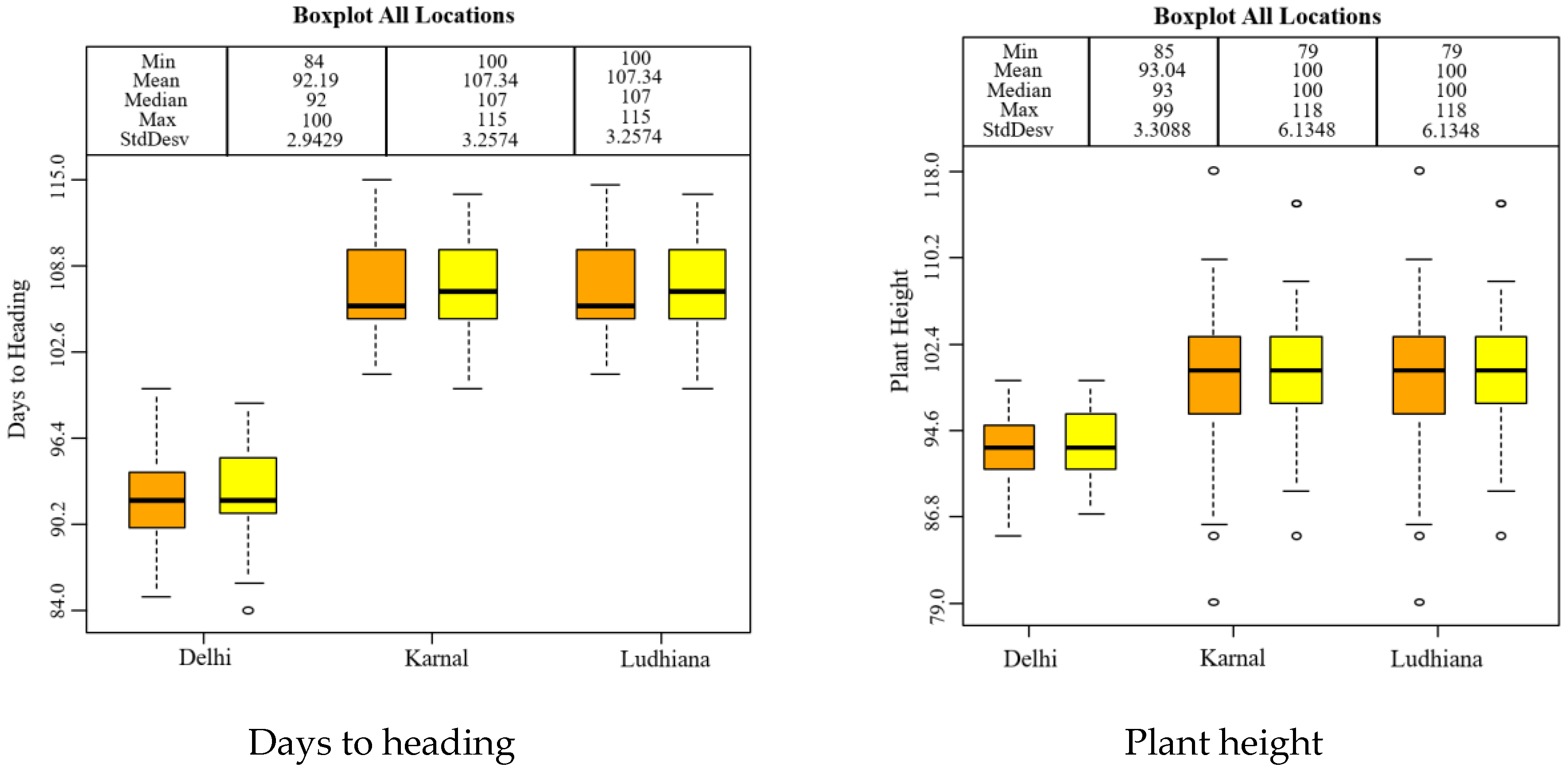Juvenile Heat Tolerance in Wheat for Attaining Higher Grain Yield by Shifting to Early Sowing in October in South Asia
Abstract
1. Introduction
2. Materials and Methods
2.1. Experiment 1: Field Trials of 3222 Diverse Wheat Genotypes
2.2. Experiment 2: Genotyping of Germplasm for Ppd and Vrn Genes
2.2.1. Genotyping of Ppd-D1
2.2.2. Genotyping of Vrn-1 Genes
2.2.3. Genotyping of Vrn-B3
2.2.4. Genotyping of Photoperiod Insensitive Ppd-A1a Mutations
2.2.5. Genotyping of SSR-Marker GWM4167 Associated to Ppd-B1
2.2.6. Genotyping of SSR-Marker GWM291 Associated to Vrn-A2
2.2.7. Marker Ppd-B1_R36-F31 Detecting Copy Number Variation at Locus Ppd-B1
2.3. Experiment 3: Field Trials of Adapted Breeding Materials under October Sowing in NWPZ and CPZ of India in Crop Season 2013–2014
2.4. Experiment 4: Field Trials of Adapted Breeding Materials under October Sowing in NWPZ of India in Crop Season 2014–2015
2.5. Statistical Analysis
3. Results
3.1. Performance of 3322 Wheat Genotypes Set for Agronomic Traits in the Early (October) SOWN Conditions
3.2. Genotyping of Germplasm for Ppd and Vrn Genes
3.3. Performance of Elite Lines in the Early (October) Sown Conditions
3.3.1. Evaluation during 2013–2014 Crop Season—NWPZ
3.3.2. Evaluation during 2013–2014 Crop Season—CPZ
3.3.3. Performance of Genotypes in 2014–2015 Crop Season in NWPZ
4. Discussion
Supplementary Materials
Author Contributions
Funding
Institutional Review Board Statement
Informed Consent Statement
Data Availability Statement
Acknowledgments
Conflicts of Interest
References
- Joshi, A.K.; Mishra, B.; Chatrath, R.; Ortiz Ferrara, G.; Singh, R.P. Wheat improvement in India: Present status, emerging challenges and future prospects. Euphytica 2007, 157, 431–446. [Google Scholar] [CrossRef]
- Chatrath, R.; Mishra, B.; Ortiz Ferrara, G.; Singh, S.K.; Joshi, A.K. Challenges to wheat production in South Asia. Proc. Euphytica 2007, 157, 447–456. [Google Scholar] [CrossRef]
- Ortiz, R.; Sayre, K.D.; Govaerts, B.; Gupta, R.; Subbarao, G.V.V.; Ban, T.; Hodson, D.; Dixon, J.M.; Iván Ortiz-Monasterio, J.; Reynolds, M. Climate change: Can wheat beat the heat? Agric. Ecosyst. Environ. 2008, 126, 46–58. [Google Scholar] [CrossRef]
- Rodell, M.; Velicogna, I.; Famiglietti, J.S. Satellite-based estimates of groundwater depletion in India. Nature 2009, 460, 999–1002. [Google Scholar] [CrossRef] [PubMed]
- Lobell, D.B.; Burke, M.B.; Tebaldi, C.; Mastrandrea, M.D.; Falcon, W.P.; Naylor, R.L. Prioritizing Climate Change Adaptation Needs for Food Security in 2030. Science 2008, 319, 607–610. [Google Scholar] [CrossRef]
- Bhatt, R.; Kaur, R.; Ghosh, A. Strategies to Practice Climate-Smart Agriculture to Improve the Livelihoods under the Rice-Wheat Cropping System in South Asia. In Sustainable Management of Soil and Environment; Springer: Singapore, 2019; pp. 29–71. ISBN 9789811388323. [Google Scholar]
- Bhanja, S.N.; Mukherjee, A.; Rangarajan, R.; Scanlon, B.R.; Malakar, P.; Verma, S. Long-term groundwater recharge rates across India by in situ measurements. Hydrol. Earth Syst. Sci. 2019, 23, 711–722. [Google Scholar] [CrossRef]
- Mondal, S.; Singh, R.P.; Crossa, J.; Huerta-Espino, J.; Sharma, I.; Chatrath, R.; Singh, G.P.; Sohu, V.S.; Mavi, G.S.; Sukaru, V.S.P.; et al. Earliness in wheat: A key to adaptation under terminal and continual high temperature stress in South Asia. Crop. Res. 2013, 151. [Google Scholar] [CrossRef]
- Beales, J.; Turner, A.; GriYths, S.; Snape, J.W.; Laurie, D.A. A Pseudo-Response Regulator is misexpressed in the photoperiod insensitive Ppd-D1a mutant of wheat (Triticum aestivum L.). Theor. Appl. Genet. 2007, 115, 721–733. [Google Scholar] [CrossRef]
- Yan, L.; Helguera, M.; Kato, K.; Fukuyama, S.; Sherman, J.; Dubcovsky, J. Allelic variation at the VRN-1 promoter region in polyploid wheat. Theor. Appl. Genet. 2004, 109, 1677–1686. [Google Scholar] [CrossRef]
- Fu, D.; ter Szucs, P.; Yan, L.; Helguera, M.; Skinner, J.S.; von Zitzewitz, J.; Hayes, P.M.; Dubcovsky, J. Large deletions within the first intron in VRN-1 are associated with spring growth habit in barley and wheat. Mol. Gen. Genom. 2005, 273, 54–65. [Google Scholar] [CrossRef]
- Bentley, A.R.; Turner, A.S.; Gosman, N.; Leigh, F.J.; Maccaferri, M.; Dreisigacker, S.; Greenland, A.; Laurie, D.A. Frequency of photoperiod-insensitive Ppd-A1a alleles in tetraploid, hexaploid and synthetic hexaploid wheat germplasm. Plant Breed. 2011, 130, 10–15. [Google Scholar] [CrossRef]
- Hanocq, E.; Laperche, A.; Jaminon, O.; Lainé, A.L.; Le Gouis, J. Most significant genome regions involved in the control of earliness traits in bread wheat, as revealed by QTL meta-analysis. Theor. Appl. Genet. 2007, 114, 569–584. [Google Scholar] [CrossRef] [PubMed]
- Griffiths, S.; Simmonds, J.; Leverington, M.; Wang, Y.; Fish, L.; Sayers, L.; Alibert, L.; Orford, S.; Wingen, L.; Herry, L.; et al. Meta-QTL analysis of the genetic control of ear emergence in elite European winter wheat germplasm. Theor. Appl. Genet. 2009, 119, 383–395. [Google Scholar] [CrossRef] [PubMed]
- Whittal, A.; Kaviani, M.; Graf, R.; Humphreys, G.; Navabi, A. Allelic variation of vernalization and photoperiod response genes in a diverse set of North American high latitude winter wheat genotypes. PLoS ONE 2018, 13, e0203068. [Google Scholar] [CrossRef]
- Kiss, T.; Balla, K.; Veisz, O.; Láng, L.; Bedő, Z.; Griffiths, S.; Isaac, P.; Karsai, I. Allele frequencies in the VRN-A1, VRN-B1 and VRN-D1 vernalization response and PPD-B1 and PPD-D1 photoperiod sensitivity genes, and their effects on heading in a diverse set of wheat cultivars (Triticum aestivum L.). Mol. Breed. 2014, 34, 297–310. [Google Scholar] [CrossRef]
- Wang, L.; Niu, J.S.; Li, Q.Y.; Qin, Z.; Ni, Y.J.; Xu, H.X. Allelic variance at the vernalization gene locus Vrn-D1 in a group of sister wheat (Triticum aestivum) lines and its effects on development. J. Agric. Sci. 2015, 153, 588–601. [Google Scholar] [CrossRef]
- Braun, H.J.; Atlin, G.; Payne, T. Multi-location testing as a tool to identify plant response to global climate change. In Climate Change and Crop Production; CABI: Wallingford, UK, 2010; pp. 115–138. ISBN 9781845936334. [Google Scholar]
- Crespo-Herrera, L.A.; Crossa, J.; Huerta-Espino, J.; Vargas, M.; Mondal, S.; Velu, G.; Payne, T.S.; Braun, H.; Singh, R.P. Genetic gains for grain yield in cimmyt’s semi-arid wheat yield trials grown in suboptimal environments. Crop Sci. 2018, 58, 1890–1898. [Google Scholar] [CrossRef]
- Singh, R.P.; Huerta-Espino, J.; Sharma, R.; Joshi, A.K.; Trethowan, R. High yielding spring bread wheat germplasm for global irrigated and rainfed production systems. Euphytica 2007, 157, 351–363. [Google Scholar] [CrossRef]
- Yan, L.; Loukoianov, A.; Tranquilli, G.; Helguera, M.; Fahima, T.; Dubcovsky, J. Positional cloning of the wheat vernalization gene VRN1. Proc. Natl. Acad. Sci. USA 2003, 100, 6263–6268. [Google Scholar] [CrossRef]
- Zhang, X.K.; Xiao, Y.G.; Zhang, Y.; Xia, X.C.; Dubcovsky, J.; He, Z.H. Allelic variation at the vernalization genes Vrn-A1, Vrn-B1, Vrn-D1, and Vrn-B3 in Chinese wheat cultivars and their association with growth habit. Crop Sci. 2008, 48, 458–470. [Google Scholar] [CrossRef]
- Yan, L.; Fu, D.; Li, C.; Blechl, A.; Tranquilli, G.; Bonafede, M.; Sanchez, A.; Valarik, M.; Yasuda, S.; Dubcovsky, J. The wheat and barley vernalization gene VRN3 is an orthologue of FT. Proc. Natl. Acad. Sci. USA 2006, 103, 19581–19586. [Google Scholar] [CrossRef]
- Distelfeld, A.; Tranquilli, G.; Li, C.; Yan, L.; Dubcovsky, J. Genetic and molecular characterization of the VRN2 loci in tetraploid wheat. Plant Physiol. 2009, 149, 245–257. [Google Scholar] [CrossRef]
- Wilhelm, E.P.; Turner, A.S.; Laurie, D.A. Photoperiod insensitive Ppd-A1a mutations in tetraploid wheat (Triticum durum Desf.). Theor. Appl. Genet. 2009, 118, 285–294. [Google Scholar] [CrossRef] [PubMed]
- Zanke, C.; Ling, J.; Plieske, J.; Kollers, S.; Ebmeyer, E.; Korzun, V.; Argillier, O.; Stiewe, G.; Hinze, M.; Beier, S.; et al. Genetic architecture of main effect QTL for heading date in European winter wheat. Front. Plant Sci. 2014, 5, 217. [Google Scholar] [CrossRef] [PubMed][Green Version]
- Díaz, A.; Zikhali, M.; Turner, A.S.; Isaac, P.; Laurie, D.A. Copy number variation affecting the photoperiod-B1 and vernalization-A1 genes is associated with altered flowering time in wheat (Triticum aestivum). PLoS ONE 2012, 7, e33234. [Google Scholar] [CrossRef] [PubMed]
- Crossa, J.; Cornelius, P.L.; Yan, W. Biplots of linear-bilinear models for studying crossover genotype × environment interaction. Crop Sci. 2002, 42, 619–633. [Google Scholar] [CrossRef]
- Evenson, R.; Pray, C.; Rosegrant, M. Agricultural Research and Productivity Growth in India; IFPRI Research Report; International Food Policy Research Institute: Washington, DC, USA, 1999. [Google Scholar]
- Mondal, S.; Joshi, A.K.; Huerta-Espino, J.; Singh, R.P. Early Maturity in Wheat for Adaptation to High Temperature Stress. In Advances in Wheat Genetics: From Genome to Field; Springer: Tokyo, Japan, 2015; pp. 239–245. [Google Scholar]
- Mondal, S.; Dutta, S.; Crespo-Herrera, L.; Huerta-Espino, J.; Braun, H.J.; Singh, R.P. Fifty years of semi-dwarf spring wheat breeding at CIMMYT: Grain yield progress in optimum, drought and heat stress environments. Crop. Res. 2020, 250, 107757. [Google Scholar] [CrossRef]
- Sandhu, B.S.; Dhaliwal, N.S.; Sandhu, G.S. Production potential and economics of wheat, Triticum aestivum as influenced by different planting methods in Punjab, India. J. Appl. Nat. Sci. 2016, 8, 777–781. [Google Scholar] [CrossRef]
- Krupnik, T.J.; Schulthess, U.; Ahmed, Z.U.; McDonald, A.J. Sustainable crop intensification through surface water irrigation in Bangladesh? A geospatial assessment of landscape-scale production potential. Land Use Policy 2017, 60, 206–222. [Google Scholar] [CrossRef]
- Reynolds, M.P.; Borlaug, N.E. Impacts of breeding on international collaborative wheat improvement. J. Agric. Sci. 2006, 144, 3–17. [Google Scholar] [CrossRef]
- Stelmakh, A.F. Geographic distribution of Vrn-genes in landraces and improved varieties of spring bread wheat. Euphytica 1990, 45, 113–118. [Google Scholar] [CrossRef]
- Van Beem, J.; Mohler, V.; Lukman, R.; Van Ginkel, M.; William, M.; Crossa, J.; Worland, A.J. Analysis of genetic factors influencing the developmental rate of globally important CIMMYT wheat cultivars. Crop Sci. 2005, 45, 2113–2119. [Google Scholar] [CrossRef]
- Stelmakh, A.F. Genetic effects of Vrn genes on heading date and agronomic traits in bread wheat. Euphytica 1992, 65, 53–60. [Google Scholar] [CrossRef]
- Singh, R.P.; Trethowan, R. Breeding Spring Bread Wheat for Irrigated and Rainfed Production Systems of the Developing World. In Breeding Major Food Staples; Blackwell Publishing Ltd.: Hoboken, NJ, USA, 2007; pp. 107–140. ISBN 9780470376447. [Google Scholar]
- Farhad, M.; Tripathi, S.B.; Singh, R.P.; Joshi, A.; Bhati, P.; Vishwakarma, M.K.; Mondal, S.; Malik, A.A.; Kumar, U. Multi-trait selection of bread wheat ideotypes for adaptation to early sown condition. Crop Sci. 2021. [Google Scholar] [CrossRef]
- Singh, R.P.; Herrera-Foessel, S.; Huerta-Espino, J.; Singh, S.; Bhavani, S.; Lan, C.; Basnet, B.R. Progress Towards Genetics and Breeding for Minor Genes Based Resistance to Ug99 and Other Rusts in CIMMYT High-Yielding Spring Wheat. J. Integr. Agric. 2014, 13, 255–261. [Google Scholar] [CrossRef]
- Witcombe, J.; Hollington, P.; Howarth, C.; Reader, S.; Steele, K. Breeding for abiotic stresses for sustainable agriculture. Philos. Trans. R. Soc. B Biol. Sci. 2008, 363, 703–716. [Google Scholar] [CrossRef]
- Paliwal, R.; Röder, M.S.; Kumar, U.; Srivastava, J.P.; Joshi, A.K. QTL mapping of terminal heat tolerance in hexaploid wheat (T. aestivum L.). Theor. Appl. Genet. 2012, 125, 561–575. [Google Scholar] [CrossRef]
- Harris, F.A.J.; Eagles, H.A.; Virgona, J.M.; Martin, P.J.; Condon, J.R.; Angus, J.F. Effect of VRN1 and PPD1 genes on anthesis date and wheat growth. Crop Pasture Sci. 2017, 68, 195. [Google Scholar] [CrossRef]
- Zikhali, M.; Leverington-Waite, M.; Fish, L.; Simmonds, J.; Orford, S.; Wingen, L.U.; Goram, R.; Gosman, N.; Bentley, A.; Griffiths, S. Validation of a 1DL earliness per se (eps) flowering QTL in bread wheat (Triticum aestivum). Mol. Breed. 2014, 34, 1023–1033. [Google Scholar] [CrossRef]
- Hill, C.B.; Taylor, J.D.; Edwards, J.; Mather, D.; Langridge, P.; Bacic, A.; Roessner, U. Detection of QTL for metabolic and agronomic traits in wheat with adjustments for variation at genetic loci that affect plant phenology. Plant Sci. 2015, 233, 143–154. [Google Scholar] [CrossRef]
- Chen, C.; Wang, B.; Feng, P.; Xing, H.; Fletcher, A.L.; Lawes, R.A. The shifting influence of future water and temperature stress on the optimal flowering period for wheat in Western Australia. Sci. Total Environ. 2020, 737, 139707. [Google Scholar] [CrossRef] [PubMed]
- Flohr, B.M.; Hunt, J.R.; Kirkegaard, J.A.; Evans, J.R. Water and temperature stress define the optimal flowering period for wheat in south-eastern Australia. Crop. Res. 2017, 209, 108–119. [Google Scholar] [CrossRef]





| Source | df | Mean Sum of Squares | ||||
|---|---|---|---|---|---|---|
| GY | Heading | Maturity | Pl Height | TGW | ||
| Genotype | 3326 | 173,725 ** | 2661.8 ** | 2574.6 ** | 1125.1 ** | 1339.0 ** |
| Error | 15,713 | 31,919 | 82.8 | 415.3 | 77.9 | 41.4 |
| F value | 5.44 | 32.14 | 6.20 | 14.44 | 32.33 | |
| GY per Plot (t/ha) | Heading (Days) | Maturity (Days) | Pl Height (cm) | TGW (g) | |
|---|---|---|---|---|---|
| Range | 1.1–8.2 | 53–112 | 70–143 | 36–121 | 18–53 |
| Var_Genotype | 1.10 | 12.19 | 2.54 | 22.17 | 6.69 |
| Var_Resid | 324.9586 | 82.82 | 415.33 | 77.94 | 41.42 |
| Mean | 4.4651 | 83.72 | 124.37 | 90.00 | 43.83 |
| LSD | 1.4 | 7 | 16 | 7 | 5 |
| CV | 13.9 | 10.9 | 6.4 | 9.8 | 14.7 |
| Heritability | 0.200 | 0.4689 | 0.354 | 0.6306 | 0.4922 |
| Source | df | Mean Sum of Squares (50 Genotypes 2013–2014) | |||
|---|---|---|---|---|---|
| GY | Heading | Pl Height | TGW | ||
| Loc | 2 | 3527.04 ** | 7650.75 ** | 1614.72 ** | 4.06 |
| Rep (Loc) | 3 | 62.04 | 2.00 | 3.96 | 9.83 |
| Genotype | 49 | 172.66 ** | 28.18 ** | 63.42 ** | 15.33 ** |
| Loc × Genotype | 98 | 111.76 ** | 8.44 ** | 31.08 ** | 15.29 ** |
| Mean Sum of Squares (30 Genotypes 2014–2015) | |||||
| Loc | 2 | 6591.66 ** | 9669.93 | 7957.21 ** | 988.24 ** |
| Rep (Loc) | 3 | 77.65 | 4.12 | 8.78 | 4.13 |
| Genotype | 30 | 132.95 ** | 10.94 | 3.77 | 9.20 ** |
| Loc × Genotype | 74.14 ** | 13.29 | 33.20 ** | 16.72 ** | |
| No. | Delhi | Karnal | Ludhiana | Mean of Locations | ||||||||
|---|---|---|---|---|---|---|---|---|---|---|---|---|
| Line | GY t/ha | % Gain over LC | Line | GY t/ha | % Gain over LC | Line | GY t/ha | % Gain over LC | Line | GY t/ha | % Gain over LC | |
| 1 | BMZ-NW-04 | 7.78 | 10.4 | BMZ-NW-07 | 6.91 | 44.6 | BMZ-NW-16 | 7.85 | 52.1 | BMZ-NW-16 | 7.35 | 29.8 |
| 2 | BMZ-NW-30 | 7.57 | 7.4 | BMZ-NW-16 | 6.71 | 40.4 | BMZ-NW-26 | 7.25 | 40.5 | BMZ-NW-07 | 7.15 | 26.3 |
| 3 | BMZ-NW-07 | 7.51 | 6.5 | BMZ-NW-40 | 6.57 | 37.4 | BMZ-NW-35 | 7.16 | 38.8 | BMZ-NW-09 | 6.60 | 16.5 |
| 4 | BMZ-NW-16 | 7.49 | 6.2 | BMZ-NW-27 | 6.22 | 30.1 | BMZ-NW-28 | 7.15 | 38.6 | BMZ-NW-04 | 6.50 | 14.8 |
| 5 | BMZ-NW-17 | 7.39 | 4.8 | BMZ-NW-06 | 6.21 | 29.9 | BMZ-NW-25 | 7.10 | 37.6 | BMZ-NW-42 | 6.46 | 14.1 |
| 6 | BMZ-NW-43 | 7.38 | 4.7 | BMZ-NW-41 | 5.93 | 24.1 | BMZ-NW-17 | 7.03 | 36.2 | BMZ-NW-29 | 6.33 | 11.8 |
| 7 | BMZ-NW-09 | 7.36 | 4.4 | BMZ-NW-29 | 5.82 | 21.8 | BMZ-NW-09 | 7.02 | 36.0 | BMZ-NW-28 | 6.32 | 11.6 |
| 8 | BMZ-NW-31 | 7.30 | 3.5 | BMZ-NW-03 | 5.78 | 20.9 | BMZ-NW-45 | 6.81 | 32.0 | BMZ-NW-17 | 6.30 | 11.2 |
| 9 | BMZ-NW-42 | 7.25 | 2.8 | BMZ-NW-20 | 5.72 | 19.7 | BMZ-NW-22 | 6.79 | 31.6 | BMZ-NW-30 | 6.27 | 10.7 |
| 10 | BMZ-NW-29 | 7.11 | 0.9 | BMZ-NW-48 | 5.65 | 18.2 | BMZ-NW-48 | 6.78 | 31.4 | BMZ-NW-06 | 6.26 | 10.5 |
| 11 | DPW 621-50 (C) | 7.50 | DPW 621-50 (C) | 6.35 | DPW 621-50 (C) | 6.97 | DPW 621-50 (C) | 6.94 | ||||
| 12 | HD 2967(C) | 7.05 | HD 2967(C) | 4.78 | HD 2967(C) | 5.16 | HD 2967(C) | 5.66 | ||||
| LSD 5% | 3.1 | 4.2 | 4.4 | 4.3 | ||||||||
| Source | df | Mean Sum of Squares (50 Genotypes 2013–2014) | |||
|---|---|---|---|---|---|
| GY | Heading | Pl Height | TGW | ||
| Loc | 2 | 4890.66 ** | 17,617.04 ** | 8631.54 ** | 7482.93 ** |
| Rep(Loc) | 3 | 136.25 | 236.11 ** | 60.85 | 12.40 |
| Geno | 49 | 5025.41 ** | 3660.75 ** | 4553.41 ** | 3364.82 ** |
| Loc × Geno | 98 | 6924.13 ** | 1464.96 ** | 1694.79 ** | 992.25 ** |
| No. | Dharwad | Indore | Pune | Mean of Locations | ||||||||
|---|---|---|---|---|---|---|---|---|---|---|---|---|
| Line | GY t/ha | % Gain over GW 322 | Line | GY t/ha | % Gain over GW 322 | Line | GY t/ha | % Gain over GW 322 | Line | GY t/ha | % Gain over GW 322 | |
| 1 | BMZ-CPZ-04 | 7.78 * | 9.1 | BMZ-CPZ-07 | 6.91 * | 44.6 | BMZ-CPZ-16 | 7.85 * | 52.3 | BMZ-CPZ-07 | 7.00 * | 23.1 |
| 2 | BMZ-CPZ-30 | 7.57 * | 6.1 | BMZ-CPZ-16 | 6.71 * | 40.5 | BMZ-CPZ-26 | 7.25 | 40.5 | BMZ-CPZ-16 | 6.85 | 20.4 |
| 3 | BMZ-CPZ-07 | 7.51 | 5.4 | BMZ-CPZ-40 | 6.57 | 37.5 | BMZ-CPZ-35 | 7.16 | 38.8 | BMZ-CPZ-09 | 6.60 | 16.0 |
| 4 | BMZ-CPZ-17 | 7.39 | 3.6 | BMZ-CPZ-27 | 6.22 | 30.2 | BMZ-CPZ-28 | 7.15 | 38.6 | BMZ-CPZ-04 | 6.50 | 14.2 |
| 5 | BMZ-CPZ-43 | 7.38 | 3.4 | BMZ-CPZ-06 | 6.21 | 30.0 | BMZ-CPZ-25 | 7.10 | 37.8 | BMZ-CPZ-42 | 6.46 | 13.5 |
| 6 | BMZ-CPZ-09 | 7.36 | 3.2 | BMZ-CPZ-41 | 5.93 | 24.1 | BMZ-CPZ-17 | 7.03 | 36.4 | BMZ-CPZ-29 | 6.33 | 11.2 |
| 7 | BMZ-CPZ-31 | 7.30 | 2.4 | BMZ-CPZ-29 | 5.82 | 21.9 | BMZ-CPZ-09 | 7.02 | 36.2 | BMZ-CPZ-28 | 6.32 | 11.2 |
| 8 | BMZ-CPZ-42 | 7.25 | 1.7 | BMZ-CPZ-03 | 5.78 | 21.0 | BMZ-CPZ-45 | 6.81 | 32.0 | BMZ-CPZ-17 | 6.30 | 10.8 |
| 9 | BMZ-CPZ-29 | 7.11 | −0.2 | BMZ-CPZ-20 | 5.72 | 19.7 | BMZ-CPZ-22 | 6.79 | 31.7 | BMZ-CPZ-30 | 6.27 | 10.2 |
| 10 | BMZ-CPZ-11 | 7.03 | −1.4 | BMZ-CPZ-48 | 5.65 | 18.2 | BMZ-CPZ-48 | 6.78 | 31.5 | BMZ-CPZ-06 | 6.26 | 10.1 |
| 11 | MACS6222 (C) | 7.20 | MACS6222 (C) | 6.35 | MACS6222 (C) | 6.97 | MACS6222 (C) | 6.84 | ||||
| 12 | GW 322 (C) | 7.13 | GW 322 (C) | 4.78 | GW 322 (C) | 5.16 | GW 322 (C) | 5.69 | ||||
| LSD 5% | 3.7 | 3.4 | 4.3 | 3.3 | ||||||||
| No. | Delhi | Karnal | Ludhiana | Mean of Locations | ||||||||
|---|---|---|---|---|---|---|---|---|---|---|---|---|
| Line | GY t/ha | % Gain over HD 2967 | Line | GY t/ha | % Gain over HD 2967 | Line | GY t/ha | % Gain over HD 2967 | Line | GY t/ha | % Gain over HD 2967 | |
| 1 | BMZ-NW-2015-6 | 8.00 | 22.0 | BMZ-NW-2015-20 | 7.74 | 25.5 | BMZ-NW-2015-25 | 7.92 | 34.7 | BMZ-NW-16 | 7.89 | 27.2 |
| 2 | BMZ-NW-2015-20 | 7.56 | 15.3 | BMZ-NW-2015-10 | 7.36 | 19.4 | BMZ-NW-2015-21 | 7.55 | 28.3 | BMZ-NW-07 | 7.49 | 20.8 |
| 3 | BMZ-NW-2015-17 | 7.40 | 12.9 | BMZ-NW-2015-23 | 7.21 | 16.8 | BMZ-NW-2015-26 | 7.49 | 27.5 | BMZ-NW-09 | 7.37 | 18.8 |
| 4 | BMZ-NW-2015-9 | 6.99 | 6.6 | BMZ-NW-2015-28 | 7.03 | 13.9 | BMZ-NW-2015-28 | 7.23 | 22.9 | BMZ-NW-04 | 7.08 | 14.2 |
| 5 | BMZ-NW-2015-28 | 6.73 | 2.7 | BMZ-NW-2015-18 | 6.76 | 9.6 | BMZ-NW-2015-27 | 7.20 | 22.5 | BMZ-NW-42 | 6.90 | 11.2 |
| 6 | BMZ-NW-2015-24 | 6.60 | 0.6 | BMZ-NW-2015-25 | 6.73 | 9.0 | BMZ-NW-2015-12 | 7.09 | 20.5 | BMZ-NW-29 | 6.80 | 9.7 |
| 7 | BMZ-NW-2015-13 | 6.42 | −2.2 | BMZ-NW-2015-24 | 6.65 | 7.7 | BMZ-NW-2015-5 | 6.87 | 16.8 | BMZ-NW-28 | 6.64 | 7.1 |
| 8 | BMZ-NW-2015-25 | 6.39 | −2.6 | BMZ-NW-2015-22 | 6.55 | 6.2 | BMZ-NW-2015-18 | 6.80 | 15.7 | BMZ-NW-17 | 6.58 | 6.1 |
| 9 | BMZ-NW-2015-10 | 6.29 | −4.1 | BMZ-NW-2015-16 | 6.23 | 0.9 | BMZ-NW-2015-3 | 6.71 | 14.1 | BMZ-NW-30 | 6.41 | 3.3 |
| 10 | BMZ-NW-2015-18 | 6.23 | −5.0 | BMZ-NW-2015-6 | 6.15 | −0.3 | BMZ-NW-2015-14 | 6.60 | 12.2 | BMZ-NW-06 | 6.33 | 2.0 |
| 11 | KACHU #1 (C) | 6.79 | KACHU #1 (C) | 5.78 | KACHU #1 (C) | 6.08 | KACHU #1 (C) | 6.22 | ||||
| 12 | HD 2967 (C) | 5.56 | HD 2967 (C) | 5.17 | HD 2967 (C) | 4.88 | HD 2967 (C) | 5.20 | ||||
| LSD 5% | 4.5 | 5.3 | 3.5 | 4.1 | ||||||||
Publisher’s Note: MDPI stays neutral with regard to jurisdictional claims in published maps and institutional affiliations. |
© 2021 by the authors. Licensee MDPI, Basel, Switzerland. This article is an open access article distributed under the terms and conditions of the Creative Commons Attribution (CC BY) license (https://creativecommons.org/licenses/by/4.0/).
Share and Cite
Kumar, U.; Singh, R.P.; Dreisigacker, S.; Röder, M.S.; Crossa, J.; Huerta-Espino, J.; Mondal, S.; Crespo-Herrera, L.; Singh, G.P.; Mishra, C.N.; et al. Juvenile Heat Tolerance in Wheat for Attaining Higher Grain Yield by Shifting to Early Sowing in October in South Asia. Genes 2021, 12, 1808. https://doi.org/10.3390/genes12111808
Kumar U, Singh RP, Dreisigacker S, Röder MS, Crossa J, Huerta-Espino J, Mondal S, Crespo-Herrera L, Singh GP, Mishra CN, et al. Juvenile Heat Tolerance in Wheat for Attaining Higher Grain Yield by Shifting to Early Sowing in October in South Asia. Genes. 2021; 12(11):1808. https://doi.org/10.3390/genes12111808
Chicago/Turabian StyleKumar, Uttam, Ravi Prakash Singh, Susanne Dreisigacker, Marion S. Röder, Jose Crossa, Julio Huerta-Espino, Suchismita Mondal, Leonardo Crespo-Herrera, Gyanendra Pratap Singh, Chandra Nath Mishra, and et al. 2021. "Juvenile Heat Tolerance in Wheat for Attaining Higher Grain Yield by Shifting to Early Sowing in October in South Asia" Genes 12, no. 11: 1808. https://doi.org/10.3390/genes12111808
APA StyleKumar, U., Singh, R. P., Dreisigacker, S., Röder, M. S., Crossa, J., Huerta-Espino, J., Mondal, S., Crespo-Herrera, L., Singh, G. P., Mishra, C. N., Mavi, G. S., Sohu, V. S., Prasad, S. V. S., Naik, R., Misra, S. C., & Joshi, A. K. (2021). Juvenile Heat Tolerance in Wheat for Attaining Higher Grain Yield by Shifting to Early Sowing in October in South Asia. Genes, 12(11), 1808. https://doi.org/10.3390/genes12111808







